 Rocky
Mountain House, Nordegg & Pacific Railway Rocky
Mountain House, Nordegg & Pacific Railway
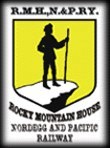 The Many Lives of Malcolm Furlow's "LGB
Empire" The Many Lives of Malcolm Furlow's "LGB
Empire"
This photo essay explains the origins, transformations, and operating concept
of this highly detailed model railroad.
Few model railways have travelled so far or offered such
spectacular scenery in Large Scale. Read the story, then scroll
on down to see extensive Photo Galleries.
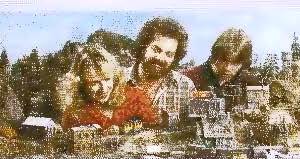 The
railway started life as an LGB of America display at their
offices in San Diego in 1986. Designed and built by Malcolm
Furlow, a well-known artist and model railroader, it became
known as "Malcolm Furlow's LGB Empire". After two on display
at LGB, it was donated to the San Diego Model Railroad
Museum. In 1992 the LGB Empire was offered for sale in Model
Railroader magazine. With only a track plan and some
terrible Polaroid snapshots, a few dollars changed hands and
the eight 4x8 modules were headed north and a bit east to
central Alberta, about 2500 miles from San Diego. The
railway started life as an LGB of America display at their
offices in San Diego in 1986. Designed and built by Malcolm
Furlow, a well-known artist and model railroader, it became
known as "Malcolm Furlow's LGB Empire". After two on display
at LGB, it was donated to the San Diego Model Railroad
Museum. In 1992 the LGB Empire was offered for sale in Model
Railroader magazine. With only a track plan and some
terrible Polaroid snapshots, a few dollars changed hands and
the eight 4x8 modules were headed north and a bit east to
central Alberta, about 2500 miles from San Diego.
In
my hands, it was called the Rocky Mountain House, Nordegg and
Pacific Railway. It is an indoor, large scale model
railroad, nominally 1:22 or G Scale, representing 3 foot
narrow gauge, running on Gauge 1 (45 mm) track.
Extensive renovation and augmentation were undertaken, including
much scenic detailing and automatic train control.
After many
years of enjoying the results of this work, the railway
was again sold to become a tourist attraction in Rosebud,
Alberta. A purpose-built structure
replicating a typical CNR station of the early 20th century houses the railway
today. While this move was proceeding, I started an outdoor
garden railway beside my ranch-house, using many of the
scenery techniques from the indoor railway, ruggedized to
handle rain and wind. See that story
HERE.
All photos
on this page were taken 1994 - 2004.
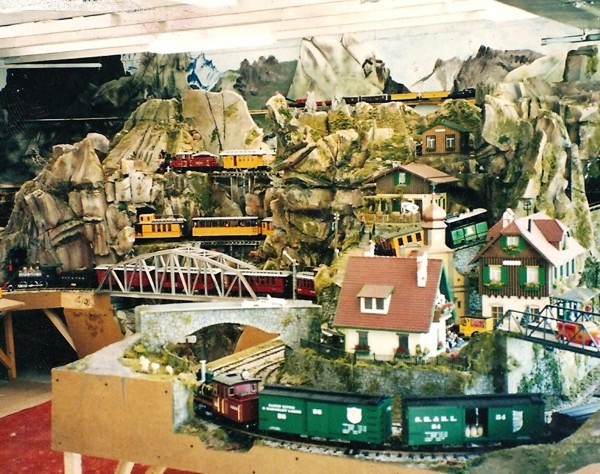
East meets West - SR&RL Forney 0-4-4T #24 at Banff Springs is on the same
level as DSP&P 2-6-0 Mogul #71 on the Gorgeous Gorge Bridge, but
will pass behind it through a tunnel. D&RGW 2-8-0 Consolidation
#268 pauses the excursion train on the 2nd level to give
tourists the view of their lives. G&D 0-4-0 Porter #2, on the
3rd level, is checking the beavers gnawing on the trestle bents
at Devil's Gulch. Steam Tram cog loco #13 runs on the 35% grade
at right between levels 2 and 3. W&A 4-4-0, the "General", hauls
a load of passengers on the 4th level in the distance.
It is an O Scale train that fools the eye, giving an impression
of great distance to the mountains.
 The
Semi-fictional History of the RMH, N&P Ry. The
Semi-fictional History of the RMH, N&P Ry.
The railway is named after two local communities served
originally by the Canadian Northern and Alberta Central
Railways.
Rocky Mountain
House is a town of about 7000 people located 5 miles west
of the intersection of
Highway
11 and Highway 22 in
Central
Alberta. It was a fur trading post established on 26 Sept
1799 by the Northwest Company on the North Saskatchewan River
in Rupert's Land, now the province of Alberta, Canada. A competing
post was set up at Acton House the same year by the Hudson's Bay
Company, a mile upstream. Nordegg, now a village about 80 miles
west of Rocky Mountain House, was originally a model community
built in 1910, with a coal mine as its focus.
Canada
was formed in 1867 and Rupert's Land became the North West Territories.
In 1905, the southern half of NWT was partitioned into two provinces
- Saskatchewan and Alberta. NWT was further split into two parts
in 1999 - the west half keeping the original name, the eastern
half being named Nunavut.
 The
RMH, N&PRy logo sports
David
Thompson, who walked, canoed, and rode horseback more than
55,000 kilometers (33,000 miles) mapping Canada and Northern USA
from Montreal to the Pacific Ocean. Between 1807 and 1811, he
explored the Rocky Mountains from Rocky Mountain House to the
mouth of the Columbia River, beyond present day Portland, OR,
making the first accurate maps of this huge tract of land. Quite
a hike! The
RMH, N&PRy logo sports
David
Thompson, who walked, canoed, and rode horseback more than
55,000 kilometers (33,000 miles) mapping Canada and Northern USA
from Montreal to the Pacific Ocean. Between 1807 and 1811, he
explored the Rocky Mountains from Rocky Mountain House to the
mouth of the Columbia River, beyond present day Portland, OR,
making the first accurate maps of this huge tract of land. Quite
a hike!
The Canadian Northern, later merged into Canadian National Railway,
came to Rocky in 1912. It went 80 miles further west to Nordegg
in 1914 to service the Brazeau coal mine that had opened three
years earlier. A competing line on a parallel route, the Alberta
Central Railway, was begun in 1910. It failed financially and
was completed by the Canadian Pacific Railway (CPR), but it never
went west of Rocky to Nordegg.
Rail
service to Nordegg was halted in 1955 due to low coal prices
and low coal demand caused by dieselization of most railways.
The line to Rocky still runs eastbound to connect to Red
Deer, Calgary, and Edmonton, carrying sulphur and grain
to the Pacific Ocean ports of Vancouver and Prince Rupert.
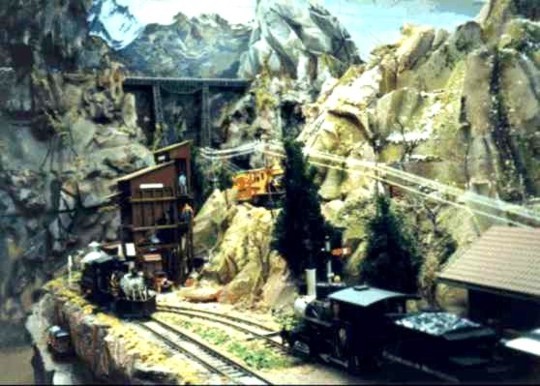
Two 2-6-0 Moguls meet at Nordegg, skirting the Randy Andy
Mine, with Mystic
Ridge in the background. A brightly painted
2-8-0 Consolidation pulls the excursion train
around Mount Allen
toward Inspiration Point.
The
(fictitious) RMH, N&P Ry. ran a narrow gauge line in 1914
from Rocky Mountain House to Nordegg, effectively extending the
CPR's line. The objective was to cross Howse Pass over the Rockies
to Golden, British Columbia (on the northbound leg of the Columbia
River), thence to the Pacific Ocean paralleling the CPR mainline. Howse Pass offers a shorter route for Central Alberta grain and
beef than the
CPR
or
CNR
lines through the Kicking Horse Pass and Yellowhead Pass routes.
Like most ambitious plans of other operators, the RMH., N&P Ry
never reached the Pacific, but instead turned south and east to
serve tourist and ski resorts of Banff and Lake Louise (Laggan)
in the Rocky Mountains.
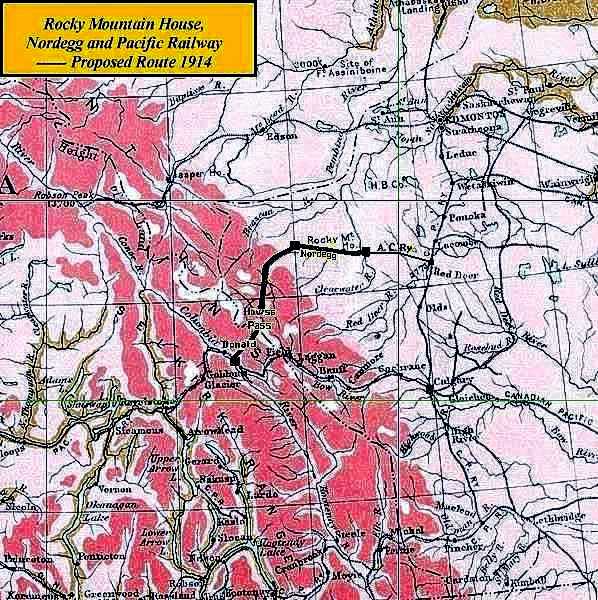
Map of the region served by RMH, N&P Ry showing other rail
lines of the 1920 to 1940 era Rocky Mountain House is
above center of the map, Banff is roughly in the middle of the
map, and Jasper is at top left.
At
the same time, the
Denver
& Rio Grande as well as the Colorado & Southern were
scaling down operations, so rolling stock for the RMH, N&P Ry. was purchased and leased from these roads. Most equipment
is still painted in the original D&RGW or C&S/DSP&P
livery.
Due
to passage of Planet Earth through a rift in space, time
now stands still, leaving the railway running permanently
on 24 May 1934, except for a small portion that got trapped
on 24 Dec 1923. May 24th is a statutory holiday in Canada,
commemorating Queen Victoria’s
Birthday – as a result many people are partying, while
others are on double overtime keeping the railways and hotels
humming.
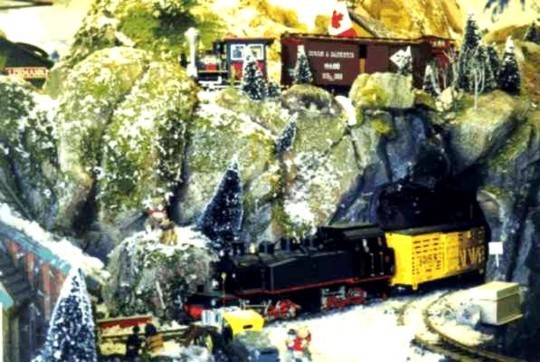
Photo
#3: RMH, N&P.Ry. "CattleLiner" #104, an 0-6-6-0T
Mallet locomotive, glides
through snowy Stoney Creek Mill with
critters for market, while Gorre & Daphetid #2.
a Porter
0-4-0, bumps its way past Daphetid Station. #104 was replaced
with Uintah #51 and rebuilt with
2-6-6-2 wheel arrangement and converted to burn oil, which had
been
discovered at Turner Valley, Alberta in 1914.
 Inception of the Layout Inception of the Layout
The model railway started life in San Diego as "Malcolm Furlow's
LGB Empire", designed and built by Malcolm as a display railroad
for LGB of America. It was a
sectional layout with styrofoam scenery, track on three levels,
and a desert/mountain motif to enhance the appearance of both
US and European style LGB rolling stock.
After
several years of use, LGBoA donated the layout to the
San
Diego Model Railroad Museum, who continued to run the display
using LGB equipment. A brief glimpse of the railway can be found
on the
Pentrex
video of the Museum. This original layout was a U-shape measuring
20 by 24 feet overall. As a side note, Malcolm also built a smaller,
highly detailed US Western-style layout for the LGB showroom in
Nuremberg, Germany, as well as several project model railways
written up for Model Railroader magazine.

Tourists on the excursion train travel along the
edge of Allen Mountain
towards Inspiration Point (upper train) with the daily express,
pulled by D&RG Mogul #19,
entering Nordegg station track (lower level). A short passenger
train is somewhat hidden by the rocky facade as it approaches Daphetid (upper level).
When the Museum needed space for new exhibits, the railway was
offered for sale in Model Railroader magazine classifieds.
After brief negotiations and a FAX of the track plan,
I decided this was the railroad for me. It was similar
enough to my dream design and with addition of a large
staging yard, would offer both point to point and continuous
operation. Museum volunteers separated the layout sections,
filled a 65 foot electronics moving van, and said goodbye
to "the monster". A few days later,
it arrived at my ranch near Rocky Mountain House, Alberta, some
150 miles north of
Calgary
(1000 miles north of Denver).

Overall view of RMH, N&P Ry. Nordegg at left, Rocky Mountain House in center foreground.
Banff Springs at right, Gorgeous Gorge Bridge at center of photo,
Sulphur Mountain right background, and Mystic Ridge at left.
Unloading the layout sections was fun! The largest piece was 7
by 16 feet, fully scenic plywood on 1 x 4 framing, and sat about
7 feet above ground on rails in the moving van. It weighed about
450 pounds. Fortunately, my brother and his family and some of
their friends from Eastern Canada and Australia were visiting,
so we had lots of strong, young bodies to lift this piece out
of the truck. If I had been forced to ask my rancher neighbors
for help, they would probably still be laughing at me. The remaining
sections were easier to lift, but more complicated to assemble
as they had as many as 3 layers of track hidden in tunnels. The
railway is now housed in a 28 x 36 foot 3-car garage, with room
for work benches, storage boxes, and visitors. The railway is
wheelchair accessible and visitors are welcome by appointment.
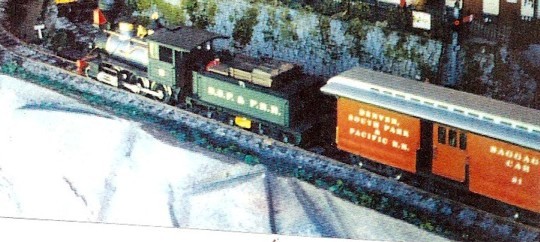
DSP&P #71 slows at Banff Springs with the "Rocky
Mountaineer", the crack express
train between Rocky Mountain House, Nordegg, and Banff
Springs.
 SIDE
TRACKS SIDE
TRACKS
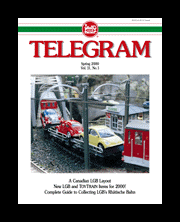 An early
version of this
Photo essay appeared in the
Spring 20001 LGB
Telegram magazine - read the full colour pdf. An early
version of this
Photo essay appeared in the
Spring 20001 LGB
Telegram magazine - read the full colour pdf.
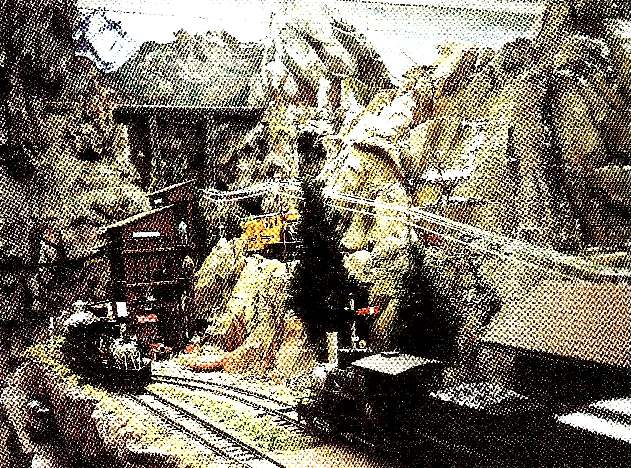 This photo appeared in LGB
This photo appeared in LGB
Telegram
magazine Fall 1998 on the
Golden Spike Awards page 
Or watch this
Slide Show with vocal by
Isobel, then do what the song says "Come Back" for
more
prose and 50+ pictures.
 Renovations Renovations
A year later, the railway was finally running with new, simplified
wiring throughout. New power packs and walk-around radio controls
were installed. Since then, I have added the staging yard, automatic
passing sidings for running trains in opposite directions during
show-and-tells, and completely renovated the scenery. The automatic
passing sidings use LGB's EPL switching system with momentum circuits
to prevent sudden starts and stops. The added realism and less
wear and tear on drive gears is worth the effort. Originally,
I used home made circuits as described in Garden Railways (April
1995). In 1999, these circuits were replaced by features built
into the LGB Jumbo transformers. The momentum is easier to adjust
and I get automatic station stops at no extra charge.
Some
track had to be replaced. During use as a display railway for
several years, engines had snagged scenery and spun their wheels
in place for hours or days, wearing notches in the railhead down
to the web at several locations. In addition, continuous wear
of the railhead on sharp curves had reduced the rail height from
Code 332 to about Code 232. Several changes were made to the track
diagram at this time to enhance operational possibilities and
the staging yard lead was cut into the middle level trackwork.

A passenger train pauses at Tiny Town to drop off children
to ride on the 1/8 scale
live steam train (N Scale) that circles the 1/8 scale grain elevator and
station.
Scenery
on the original railway was dramatic but bare, the better to show
off the LGB rolling stock. I have repainted all the styrofoam
which had faded badly. I used spray cans of acrylic enamel in
many colours and overlaid this with a pebble finish spray, without
using the clear gloss overcoat provided. I replaced the original
over sized ballast with scale sized ballast (#1 and #2 chicken
grit), and added grass, weeds, trees, roads, people, signs, vehicles,
animals, fences, and snow on the upper elevations. These changes
represent Western Canadian prairie, foothills, and mountains rather
than the desert and dry Alps of the original. It utterly amazes
me how these details determine the character of the railway, yet
go virtually unnoticed when they are missing.
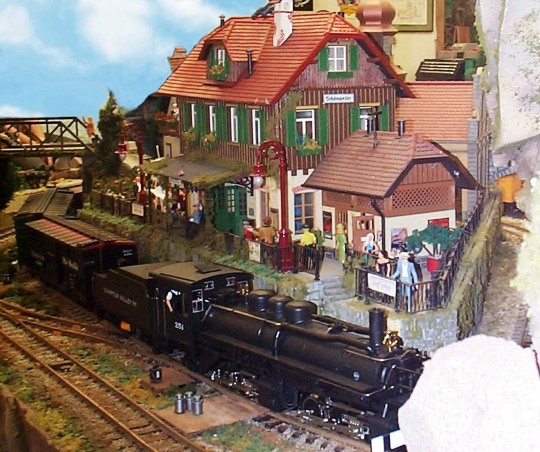
RMH,N&P.Ry Mallet #251, with the cattle train in
tow, coasts past Banff Springs
Station and Hotel. The hotel has
a full interior on two floors, and numerous patrons inside
and
out. It's a busy place, full of life and interest.
The
European theme of the mountain town was converted to a typical
Rocky Mountain resort town with only minimal effort, mainly changing
the language of signs and adding local signage and names.
I
also added tabletop to floor scenery around the layout, thus breaking
up the straight lines of track along the edges. It is now much
easier to photograph the railway with this scenery in place of
the original green curtain. Blue carpet with a white fleck was
used to cover areas of floor that represented water, and a brown
runner was used elsewhere to represent dry gulch areas. These
also help photography as well as the overall visual effect.

Ross Crain beside his kit-bashed work train at Cow Creek
Yard, with the
painted backdrop behind. Lots of junk and
clutter, spare parts, tools, and dirt make this
train a unique work of art.
My
hired hand at the time, Eric Hazen, painted the 60 foot backdrop
behind the staging yard, along the nack wall) and one end
wall. It makes a great photographic background from nearly any
angle. An obligatory mirror is used to double the size of the
staging yard (and the backdrop). Eric also did most of the floor
to tabletop styrofoam, and deserves a lot of credit for the overall
artistic effect.

Photomontage of Cow Creek Yard and the backdrop
painted by Eric Hazen. A mirror at the left stretches the
impressive mountains far to the west, and the 3-D scenery of
Mystic Ridge stretches the backdrop around the east wall at the
right. See larger views here
150KB
650KB
 Operations Operations
There's lots of action on the R.M.H.,N.&P.Ry. Three independent
loops can run two trains each in automatic mode. The mainline
oval can be separated into two ovals, allowing one additional
train to run. A Lionel 4-4-0 General runs continuously in the
distant background. A 1/8th scale amusement park train (N scale)
hauls children around its oval at Tinytown. A cog railway automatically
climbs and descends a 25% grade and a dual cable car hauls skiers
from the upper cog station to higher peaks. And the yard can be
run independently to make up the next train - a total of 10 trains
plus cable car! The original "LGB Empire" could run
4 trains on ovals, plus the cog.
In
manual operation, trains start at Cow Creek Yard, traverse all
track (except the upper oval) and return to Cow Creek, a trip
of over 900 feet. Allowing for station stops, this takes about
45 minutes plus a thorough knowledge of the track diagram. There
are about 120 feet of track in Cow Creek Yard and 425 feet on
the mainline. Train control is by way of Aristo-Craft Train Engineer
walk around radio systems to five electrically isolated blocks
powered by three LGB Jumbos and one PH Hobbies dual 10 amp power
supplies.
In
automatic mode, direction and momentum are controlled by EPL relays
and the LGB Jumbo features; in manual mode, direction, speed,
and momentum are set by the radio controllers. The cog, Tinytown,
and the Lionel General each have separate transformers set for
a reasonable steady speed.

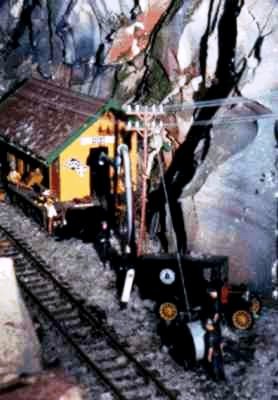
Scenes along Gorre Canyon.
The "Nordegg Flyer" pulled by 2-6-0
Mogul pauses at Gorre Station, while 2-8-0 Consolidation #286 pulls out of Allen
Tunnel with the excurs-ion train. Close-up at right is one of
many mini-scenes
- a telegraph crew stringing new lines.
 Rolling
Stock Rolling
Stock
Locomotives are mostly LGB - Moguls, Porters, a Steam
Tram, and a Diesel Switcher. These are dressed in
D&RGW liveries and are unweathered. I like to think that the railway is
well maintained, even though it is 1934. Passenger cars are
also all LGB to attain consistency in size and shape. Passenger
trains are set up to represent specific "named
trains"
running to an imaginary schedule.
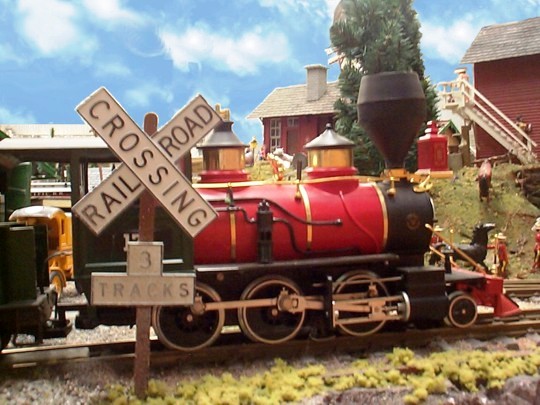
Close-up of DSP&P Mogul #17 at the Nordegg level crossing, departing
the station
for it's next stop at Rocky Mountain House. In automatic
mode, trains stop smoothly, then
depart, all stations on the layout.
In manual mode, trains are controlled by walk-around
radio transmitters
with built-in momentum.
Freights run
as "extras" with some mixed train service when LCL
freight is moved. Freight car stock is a mix of LGB and USA Trains,
with a few Delton and Bachmann. Some are weathered, some are kit-bashed,
a rare few are scratch built. All have USA Trains knuckle couplers
added for realism and ease of use - these are the smallest couplers
available and look much more realistic than other brands. As well,
Dean Lowe metal wheels were added for rolling and tracking improvements.
The wheels and visible portions of the rails are painted with
Floquil Rust and Rail Brown to tone down their appearance.
Some
locos have sound built in; others are being updated to sound as
time permits. Sound really makes a difference in large scale,
especially when trains are hidden from view or lost in a tunnel.
Cow and sheep sound cars are also helpful in tracing specific
trains.
Another
interesting side note: LGB didn't make a really old fashioned
steam rack locomotive, so I put two extra traction tires on the LGB 2050 Steam Tram. It climbs the 25% cog railway gradient with
one passenger car just fine. It runs on an LGB timed reversing
circuit. I had to add 4 diodes in series on the downhill power
lead, though, to slow the locomotive enough so it would stop properly
at the bottom of the hill.
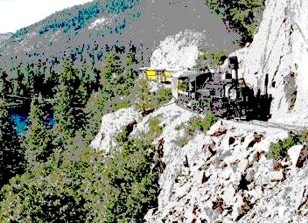

The real thing - D&SNG in Animas Canyon, CO.
(photos from the web)
The
spiral tunnel joining the lower to the middle level is about
a 10% grade and completely out of sight. It requires a Mallet
or double headed Moguls to pull two or three cars up this
grade. A train can get lost here for quite a while before
someone notices it has gone missing.
My
favorite train is my series of work train cars kitbashed from USA Trains
equipment.
These have been extensively modified - the long flatcars were
shortened to take USA Trains truss rod underframes. This allows
these cars to match the length of LGB equipment and negotiate
the sharp curves without snagging scenery or looking silly. Lots
of junk, dirt, tools, and supplies decorate each car.

Click here for
large image (240KB)
huge image (2.4 MB)
My rotary snowplow train has been upgraded with the snowplow
tender, water car, extra coal car, and crew cars. The plow itself
has received a detailed boiler backhead and cab roof over the
fireman's platform to make it look more like pictures of
the real thing. A kitbashed steam shovel ditcher is a recent
addition and a pile driver car, a pusher snowplow
(kit-bashed from an AristoCraft plow) and ballast cars have also
been included in the MOW fleet.
Weathering
is done with dry Tempera poster paints rubbed and brushed on.
The woodgrain finish holds this well and the stuff can be washed
off to create a pristine out-of-the-box look when needed.

View across RMH,N&P Ry territory. Rocky Mountain
House Station in
foreground, Cow Creek Yard in
background.
 Scenery Scenery
As mentioned earlier, scenery is styrofoam on plywood tabletops
with 1 x 4 framing. Legs are 2 x 2 with diagonal braces. Main
track level is 24 inches above floor level (done in San Diego
so children could see better). The staging yard is at 34 inches,
middle level tracks are at 33 inches, and upper level is at 60
inches. The O-27 section is at 70 inches. The tallest mountain
reaches 96 inches.
Track
ballast is chicken grit, dusted with various colours to liven
it up. Commercial coarse-ground foam is used for grass and weeds.
More than 20 gallons of white glue hold all this in place. Trees
are a mix of Christmas decorations (Balsami Metallicus var. Plastica)
in many sizes, with some real twigs and Spanish moss from my woodlot.
The original "LGB Empire" had a single, lonesome cactus.
There are now more than 200 trees ranging from 2 to 18 inches
tall.

An elk stares at the tourists as they pass Mount Allen on
their way to
Inspiration Point and Gorgeous Gorge. The tourists
are probably looking the other
way. The styrofoam mountains are
painted with acrylic sprays and an overcoat of
pebble finish in
a lighter colour.
Most buildings are Pola kits, but some Piko and Aristo-Craft are
included. Most are repainted or modified in some way, particularly
the roof materials. Most have low-fi interiors (Playmobile and
Mattel). A major project is underway to finish critical interiors
and lighting. The Banff Springs Hotel has full lounge and bedroom
detail, several houses are also complete, and two of four stations
are well underway. Most exteriors have lots of appropriate "stuff"
laying about.

Young ladies are sunbathing at
the dock on Crimson Lake. Admiring moose
and gulls look on. The
passing motorist is having a tough time staying on the road.
A reasonable population is needed to bring buildings and scenes
to life. Preiser, Elita Modelle, Flintstone, LGB, Jones,
and Just Plain Folk are used. Animals of all types, wild
and domestic, are tucked anywhere an animal should be.
All open vehicles have drivers and passengers. The total
population now exceeds 5500, counting all humans, animals,
and birds. My wife hand painted more than 150 birds to represent
species in our neighbourhood, using the colour images in
Petersen's wildlife guide books.
I have modernized the railway
by moving the era up to 1934 - 1940 instead of 1924 - 1930. This
involved removing the most antique vehicles, ditching the Victorian
ladies, and rearranging a few mini-scenes. I also tuned the rolling
stock to reflect 100% D&RGW instead of the broad mix of
my earlier roster. This railway is constantly evolving, so it
never looks exactly the same from year to year. As a result,
some of the photos show scenes that no longer exist or are
slightly
different than the present model.
 Track Plan Track Plan
The
track plan, on paper, looks like a bowl of spaghetti, much like
the real narrow gauge railways, but scenery and multi-level track
segregate the various loops. Mountains and trees break the view
so individual portions of the railway cannot be seen all at once.
Various
tunnels, including the spiral tunnel from the lower to middle
level, cause visitors to lose trains that re-appear at unexpected
places and times. These features, combined with the passing sidings,
make continuous round the loops operation interesting for at least
two hours - visitors are seldom disappointed. Manual operation
of several trains by walk around radio control is also possible,
but there are few railroaders in my rural neighbourhood, so show-and-tell
runs are the norm.
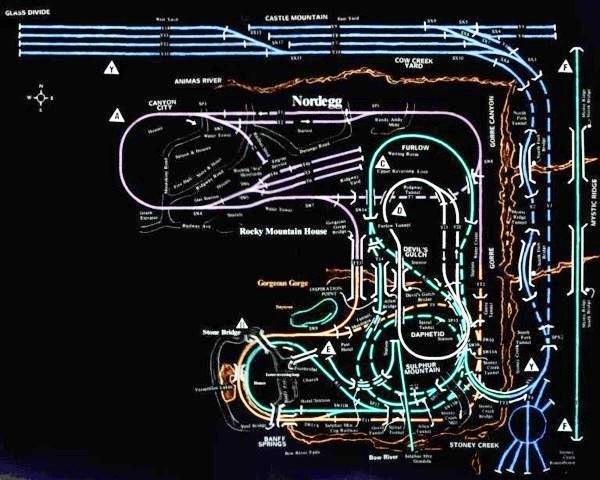
Track plan for the R.M.H.,N.&P.Ry. Click on the image
to see a larger view.
 Photo
Gallery #1 - Scenic Details Photo
Gallery #1 - Scenic Details
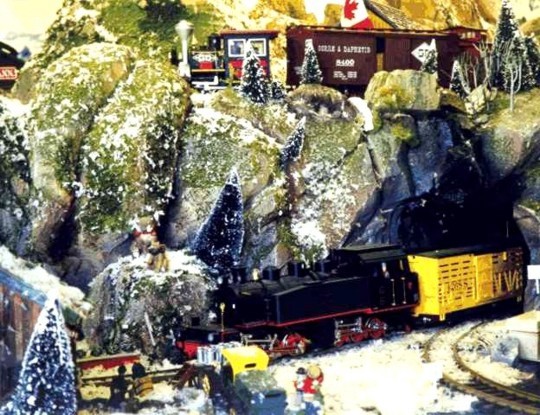
RMH,N&P RR 0-6-6-0 Mallet #104 pulls the "CattleLiner" past
Stoney Creek Mill. Above, Gorre and Daphetid 0-4-0 Porter #2, the
"John A", chuffs by with the daily freight. This portion of the
model railway is dedicated to the late John Allen, who inspired me
(and thousands of others) to improve their modeling skills well past
the toy train stage. The locomotive is an LGB Porter with custom
lettering made on a copy machine. The boxcar is from the NMRA
Heritage series, and the caboose is scratch built, with complete
interior - including eggs frying for the crew breakfast.

Close-up of the G&D train. The scenery is styrofoam with a
plywood underframe for the trackbed. Snow is standard Christmas
decoration as are many of the trees. This train runs on an
independent loop of track, alternating with a Grizzly Flats open air
(brrrr) excursion train. The two trains pass at a siding with an
automatic circuit with realistic momentum to eliminate sudden starts
and stops.
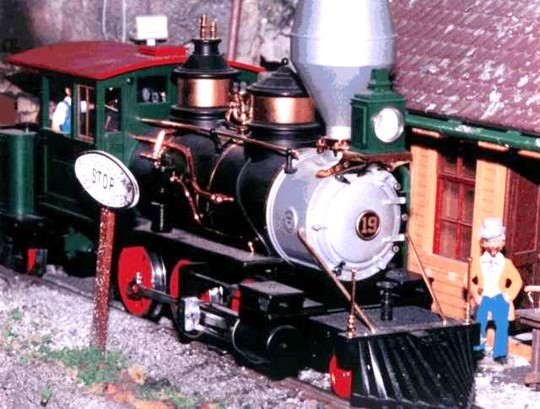
RMH,N&P 2-6-0 Mogul #19 pulls into Gorre station on trackage in west
central Alberta, Canada. Some RMH,N&P rolling stock is leased from
D&RG and C&S, so they have not been repainted or renumbered. Most
buildings on the railway have lighted and representational
interiors, so that you can see "action" through the windows.
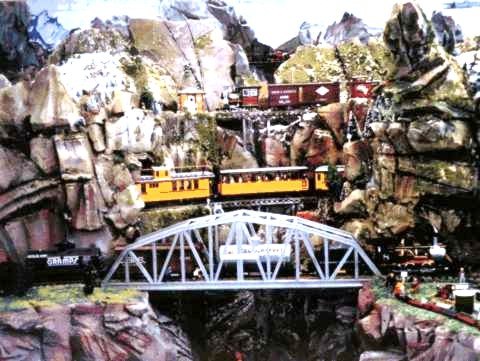
A posed shot at Gorgeous Gorge bridge with a RMH,N&P RR freight
headed for Banff Springs. Next is the RMH,N&P excursion train pulled
by 2-8-0 Consolidation #268 stopped at Inspiration Point for the
photographers on board. Above is the G&D daily freight at Devils
Gulch, and barely discernible in the distance, the Mystic Ridge
Express bores through the mountains. This latter train is actually O
scale instead of G scale to give the illusion of greater distance.
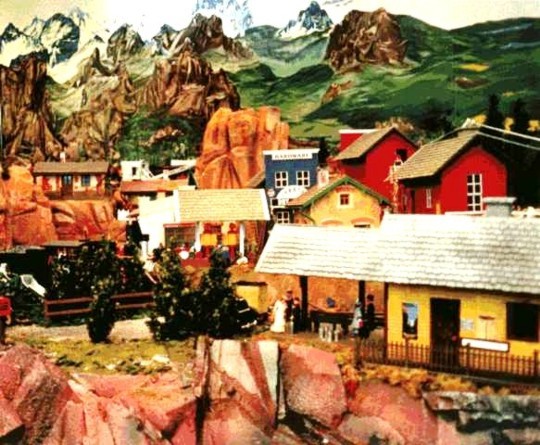
C&S 2-6-0 Mogul, on lease to the RMH,N&P, approaches Rocky
Mountain House station. Departing lovers kiss goodbye. Workers load
freight. Loiterers loiter. The Town of Rocky Mountain House is in
the middle distance and Cow Creek Yard is at the rear. The backdrop
painting of the Rocky Mountains extends more than 60 feet along two
walls of the railway room. Sharp eyes may discern Glass Divide, a
mirror that doubles the yard and backdrop to the left of the photo.
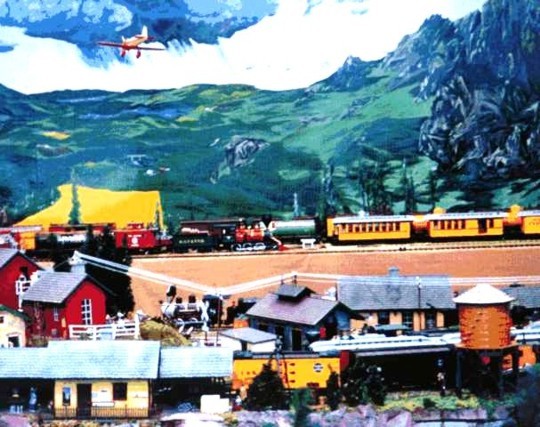
Another view of Rocky Mountain House, east of the previous photo.
Mogul #8 is about to take on water, after which it will head across
Gorgeous Gorge to Tinytown and Banff Springs. Engine servicing
facilities are hidden by the passenger cars parked just behind the
freight train. All trains stop here when running in automatic mode.
Cow Creek East Yard is in the background, nestled at the base of
Castle Mountain.
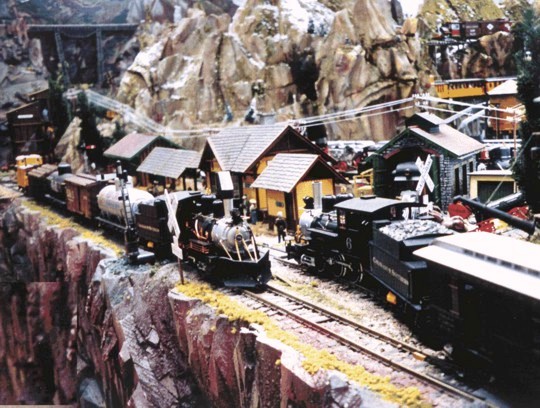
The local freight is "in the hole" waiting for the RMH,N&P "Rocky
Mountaineer" to pull into Nordegg station. These trains pause at the
station and pass each other automatically when the railway is in
automatic (show-and-tell) mode. Mystic Ridge is in the far
background. The RMH,N&P excursion train is paused at Furlow (named
after another of my modeling heroes) at the right side of the photo.
The Randy Andy Mine, owned by one of the Crown Princes of Europe,
delivers silver ore to trucks or railway cars on the left. Floor to
ceiling scenery adds to the feeling of "being there", and is
enhanced by locomotive sound systems as well as ambient sound tapes
playing in various corners of the room.
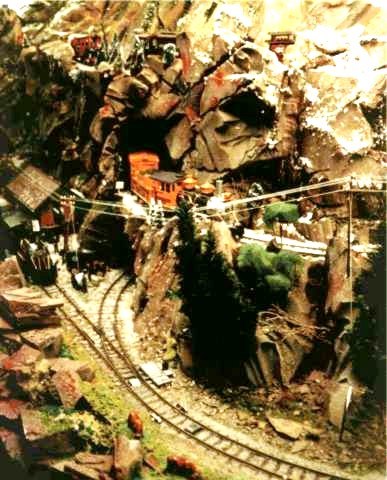
A Bell Telegraph crew is stringing new wires - one of dozens of
mini-scenes that provide action on the railway. This one is just
north of Gorre station. The RMH,N&P excursion train is creeping out
of Gorre Tunnel towards Furlow and Inspiration Point. At top left,
the Grizzly Flats 0-4-2 "Chloe" waits patiently for the G&D freight
(barely visible in the rock cut at center right) to pull into the
passing siding.
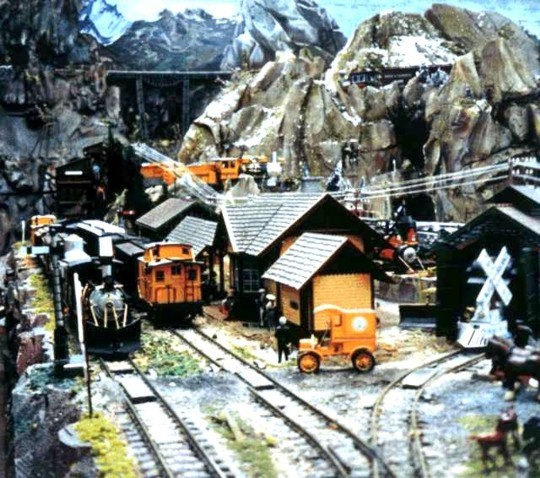
Moguls meet at Nordegg. The railbus is peeking from it's shed at
the right. Careful attention to ballast, grass, weeds, and trees
give an illusion of realism that is hard to achieve in smaller
scale model railroads. People, animals, and vehicles bring life
to the scene. Add sound and motion and you can virtually smell
the real thing as it rumbles by. Three different tape recorders
play sounds of birds, crickets, water flow, storms, distant
trains at work, loons, and wolves. Even with no trains running,
the layout is still alive.

The tail end of a mixed train leaves Nordegg, passing the Randy Andy
Mine on the right, headed through Gorre Canyon. Across the canyon,
Cow Creek Yard's diesel switcher #50 heads over North Fork Bridge.
High above is the O scale trackage spanning the upper reaches of
North Fork on a spindly steel trestle. The Mystic Ridge Express runs
only once a day, so it is difficult to catch it on film while
crossing the bridge.
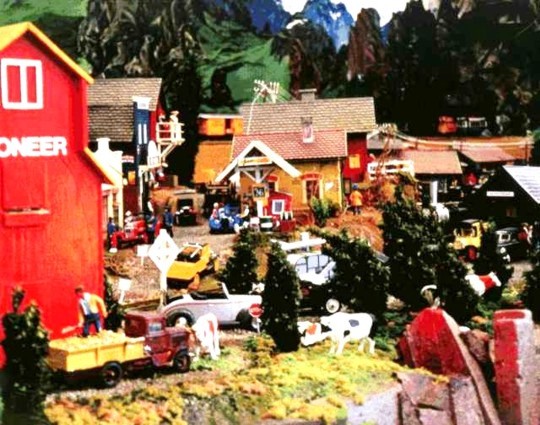
Mainstreet in downtown Rocky Mountain House is a busy place.
The railway station is at the right, the rail yard directly behind
at right rear. In town a mechanic wreaks havoc on an auto engine in
the open air gas station, ladies of the night get some daylight at
the hotel, a farmer unloads his grain at the grain elevator amid a
herd of milk cows bellowing for their share - just like real life in
small town Alberta in 1934.
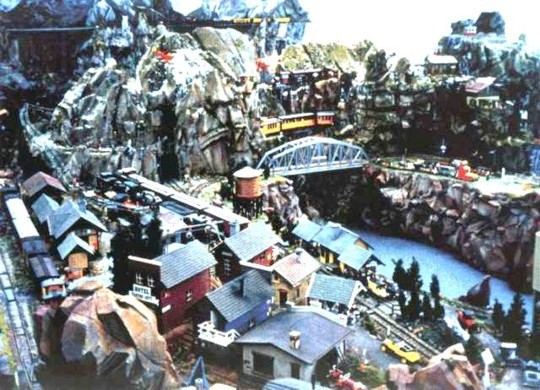
Overview of some of RMH,N&P RR territory taken from the Stearman
Biplane. Nordegg at left, Rocky Mountain House at center, Tinytown
and Banff Springs at right. Gorgeous Gorge and Devils Gulch are in
center above Rocky, with Mystic Ridge far behind. Tinytown is built
in N scale to represent a 1/8 scale model village and ride-on train.
A cog railway runs from Banff Springs to Sulphur Mountain
where skiers and hikers catch the Gondola to higher peaks (right rear
of photo).

The Sulphur Mountain Gondola leaves the base station headed to
"The Top". The Sulphur Mountain cog tramway connects this
station to Banff Springs via a 35% grade. Skiers and sight-seers
can be found around the station and on the slopes. Gondolas of
this design still operate at Jasper, Alberta and more modern
versions run up the real Sulphur Mountain near Banff, Alberta.
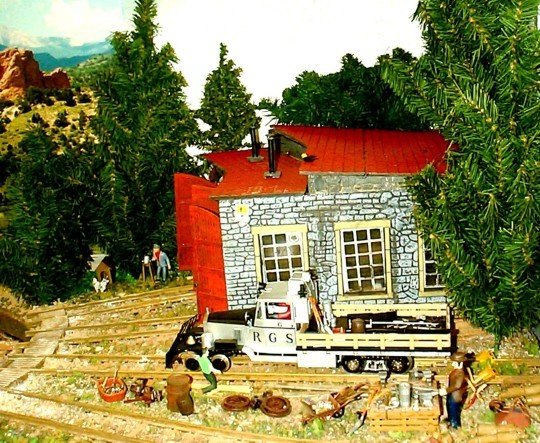
Work Goose #6 sits waiting for orders at Stoney Creek
Roundhouse. The background mountains are a real photo of the
Garden of the Gods south of Denver, taken an a vacation trip.
The round house is a pair of kit-bashed and weathered Pola
engine house kits. The foreground is the car repair yard and is
littered with spare parts, a work bench, and assorted tools. The
repair crew is on coffee break according to Section 23.12.40 of
the collective agreement.

In the bright early morning sun, Galloping Goose #2 passes
Nordegg water tower, holding up traffic on the Nordegg high road. It
will deliver mail and LCL freight to all points on the railroad. The
bikers in 1924 are very friendly and are patiently waiting for the
beer delivery man to unload his barrels from the horse drawn wagon.
Two Mercedes drivers rallying to an unknown destination are
frustrated by the delay, but their female companions seem
undisturbed.

At Furlow Station, the smallest train station in the world, the
RMH,N&P excursion train slows for orders, while a lonely elk looks
on from the mountain side. The train will soon stop at Gorgeous
Gorge so passengers can admire the tremendous view. While stopped at
the Gorge, the RMH,N&P "Cattle Liner" will pull in behind the
excursion train and continue on to Stoney Creek Mill and back to
Banff Springs via the Spiral Tunnel - all this is under automatic
control when desired.

Rocky Mountain House Yardmaster, George Patrick, stands in front of
his tiny yard office. He will soon dispatch the crack "Rocky
Mountaineer" express, which will pick up passengers at the station
and run the full length of the railway. A double headed freight is
just pulling past the Sunchild Reserve, where an RCMP officer is
checking for contraband. Inhabitants of the teepee have a gorgeous
view of Gorgeous Gorge, just off screen to the right. This photo was
taken from the top of the RMH water tank.
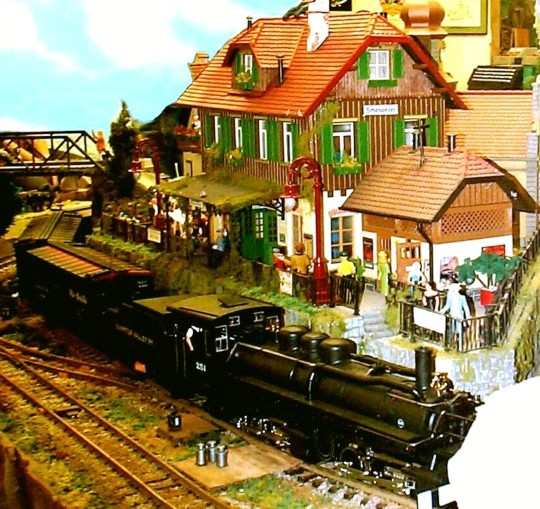
RMH,N&P's new 2-6-6-2 Mallet, purchased from the Sumpter Valley
and replacing Old #104, loafs past Banff Springs Station and
Hotel with the "Cattle Liner", headed for the Spiral Tunnel. The
cattle will be let out to graze in High Country until fall. This
is a pretty noisy trip as the curves are sharp, the track is
rough, and there is a sound unit in every car!
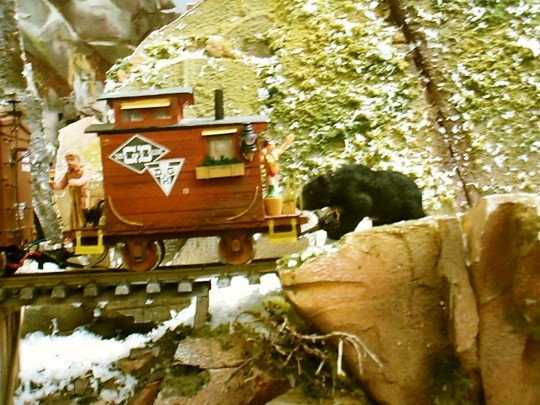
A really angry black bear chases the G&D freight train that woke
her from a deep sleep when the engineer blew the whistle at an
inappropriate location. A passenger on the caboose platform
waves her off, but this effort is futile - the bear never gives
up, but never catches up. (The tow wire won't let her.)
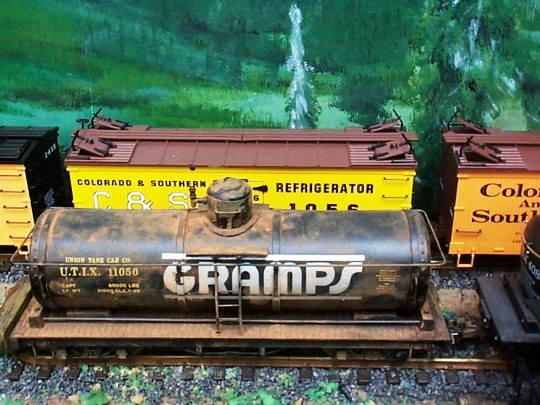
A dirty and forlorn Gramps tankcar sits in Cow Creek Yard next
to some cleaner refrigerator cars. Weathering is done with dry
poster paints, brushed on where dirt would normally collect. The
weathering will wash off completely if a pristine car is needed,
much like the real thing. A light spray of Dullcoat will hold
the dirt in place but makes it harder to clean up.

The "Nordegg Flyer", with double-headed wood-burning Moguls,
pulls into Nordegg Station. Snow on the mountains suggest fall
is approaching, with hints of the winter to come. The opposing
train will appear shortly, and will pause long enough for the
Flyer to make its journey on the single track mainline - all
controlled by automatic circuits leaving the owner/operator of
the railway time to visit with guests and passers-by.

The Gorre and Daphetid local freight trundles across Devil's
Gulch bridge, where it will pause (automatically) to unload
freight at the second-smallest station in the world. This train
is my memorial to John Allen, whose modeling and photographic
skills have influenced me for more than 50 years. He set the
stage for artistic scenery that is the backbone of hundreds,
maybe thousands, of model railways. Hardly an issue of Model
Railroader fails to mention his name as an inspiring force in
our hobby.
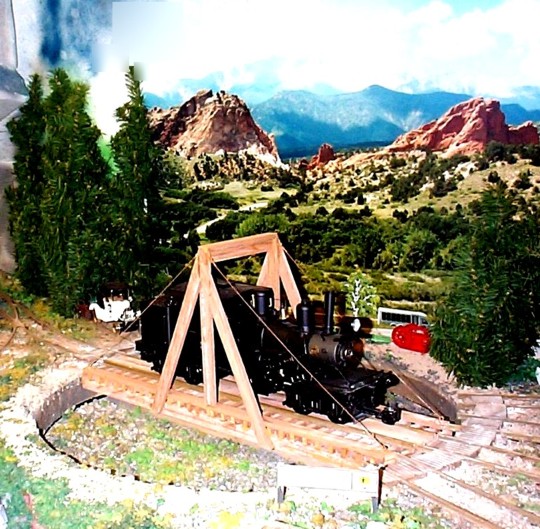
The gallows-style turntable at Stoney Creek Roundhouse holds
RMH,N&P Climax #5 for a few moments while the engineer admires
the view over the Garden of the Gods. There is nothing like a
real photo for a backdrop to give that sense of depth found in
the real world. The turntable is built on a lazy susan and is
rotated manually, just like the original. The turntable pit
floor revolves with the turntable but most people don't notice
this strange mutation of the laws of physics.

At Banff Springs stone bridge the "Nordegg Flyer" passes the
"Cattle Liner". A dozen mini-scenes can be found, from
beach-bunnies, sheep with a shepherd, a sheriff fishing beside a
No Fishing sign, a pair of moose ogling each other (or the beach
bunnies), cranes and herons, to bears posing for photos. Can you
find the ducklings?
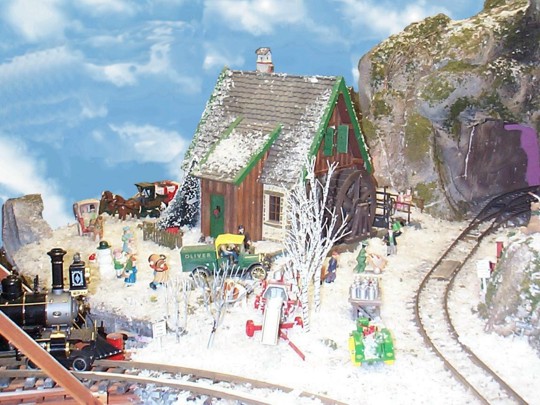
There is a lot of snow in Canada! Here at Stoney Creek Mill, RMH,N&P
4-4-0 #27 pokes her nose off Stoney Creek Bridge on a frosty
December afternoon. Christmas presents and foodstuffs arrive on
foot, by horse-drawn buggy and by automobile. The track at right
heads off to the Spiral Tunnel down to the lower level. The backside
of Sulphur Mountain looms above the scene.
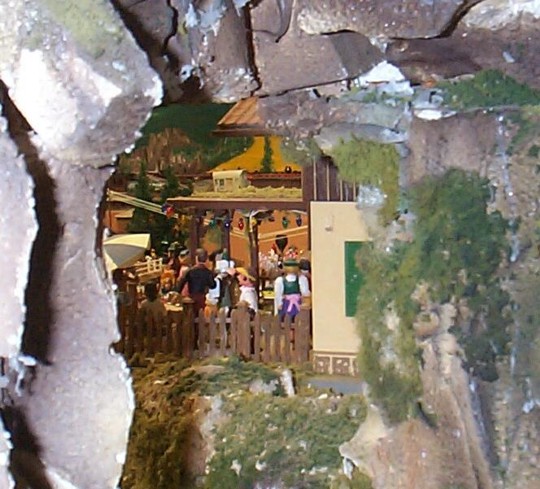
Passengers on the cog tram up Sulphur Mountain can look back through
a short tunnel at the Post Hotel. Beer and wine, good food, zither
music, and fantastic scenery greet the patrons here.
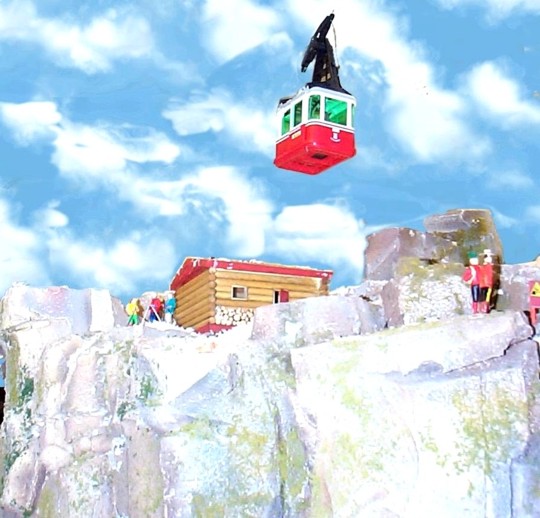
More snow - the gondola up Sulphur Mountain runs even in near
white-out conditions. Visitors to the log cabin and skiers on the
steep hills barely notice the minus 20 degree temperatures.
 Photo
Gallery #2 -- Miniscenes Photo
Gallery #2 -- Miniscenes
Creating miniscenes is one
of my favourite facets of the model railroading hobby. This page
shows some of my favourites from my indoor Large Scale layout. I
had been building such scenes on my HO and HOn3 layouts many
yeatrs before and it is even easier in Large Scale.
There
are many miniscenes to draw the eye to specific
places on the layout. Mini-scenes shown here include a Christmas party
in a remote corner of the railway, beavers
chewing a bridge support, a hunter aiming at distant deer,
linemen stringing new telegraph wire, diners at an outdoor
restaurant, geese escaping from a cage on a baggage cart,
a school band practicing, firemen washing the fire truck,
a biker gang partying and holding up traffic, a wingwalker
on a biplane, a traffic accident with nurse and ambulance,.....
If you can dream it, you can make it come alive on your
railroad.
Click of highlighted photo caption to see a larger image. Look
at the details and write your own expanded caption.
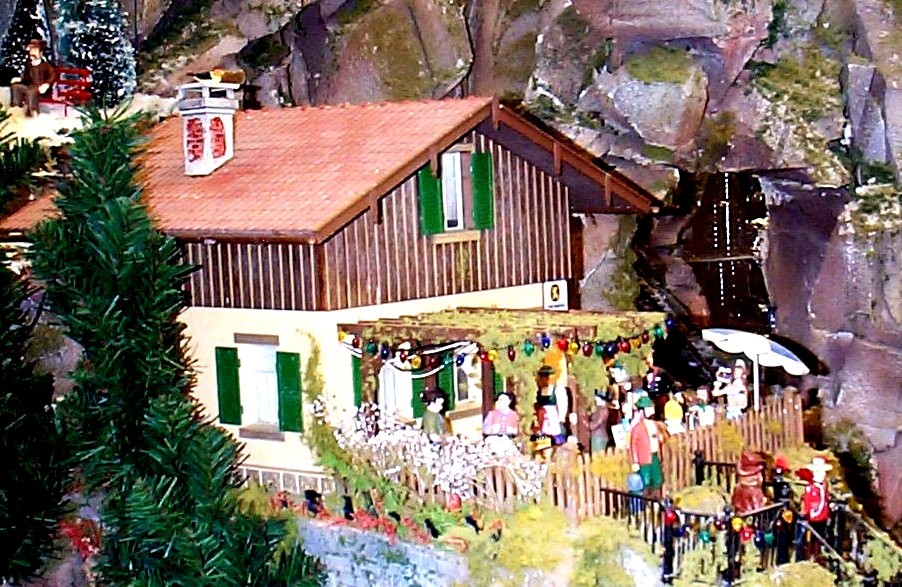
Post
Hotel -
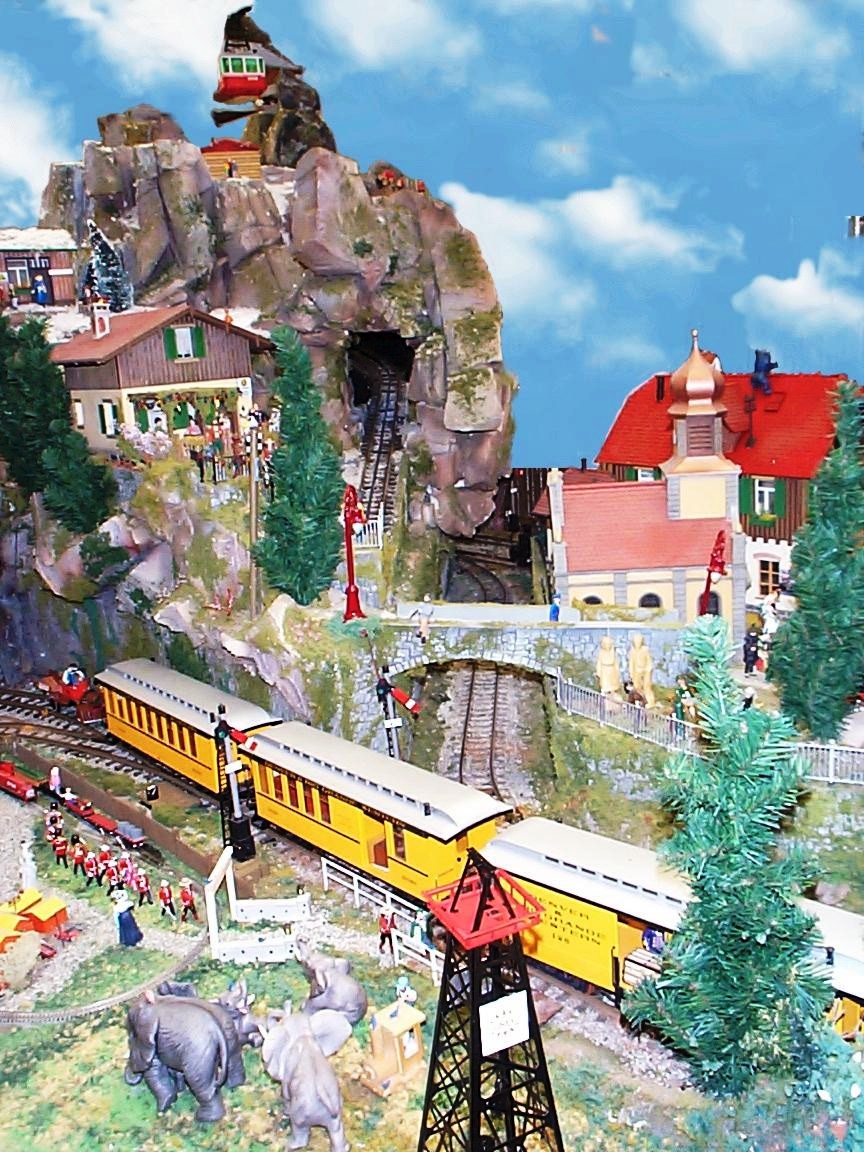
Cadet
Parade -

Moose
Crossing -
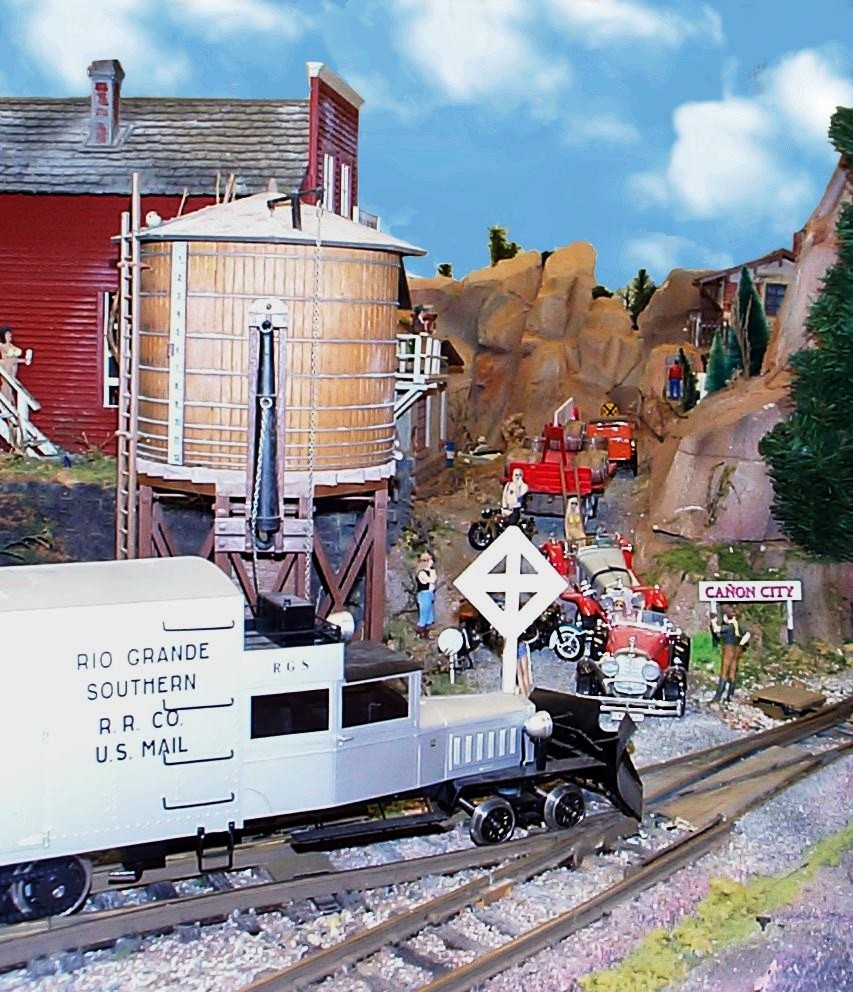
Galloping
Goose #2 -
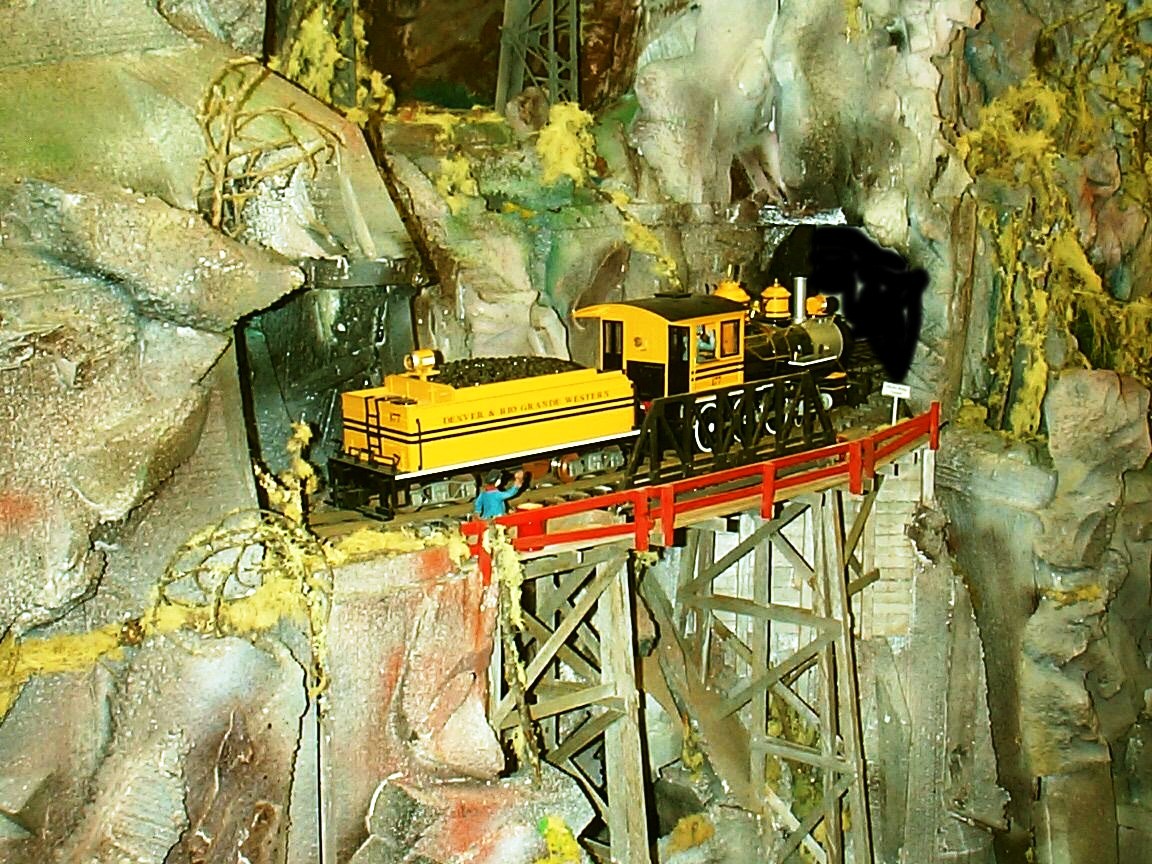
Mystic
Ridge
Trestle
-
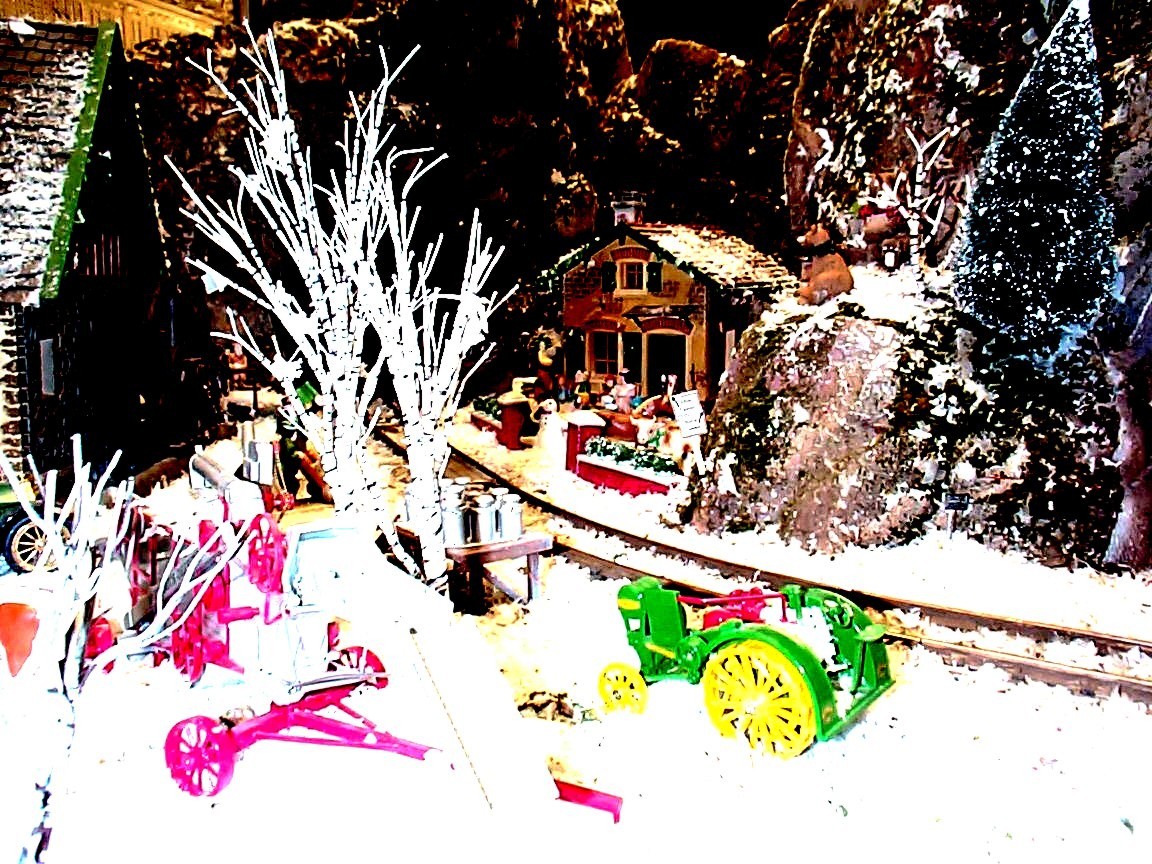
Snow at
Farm House -
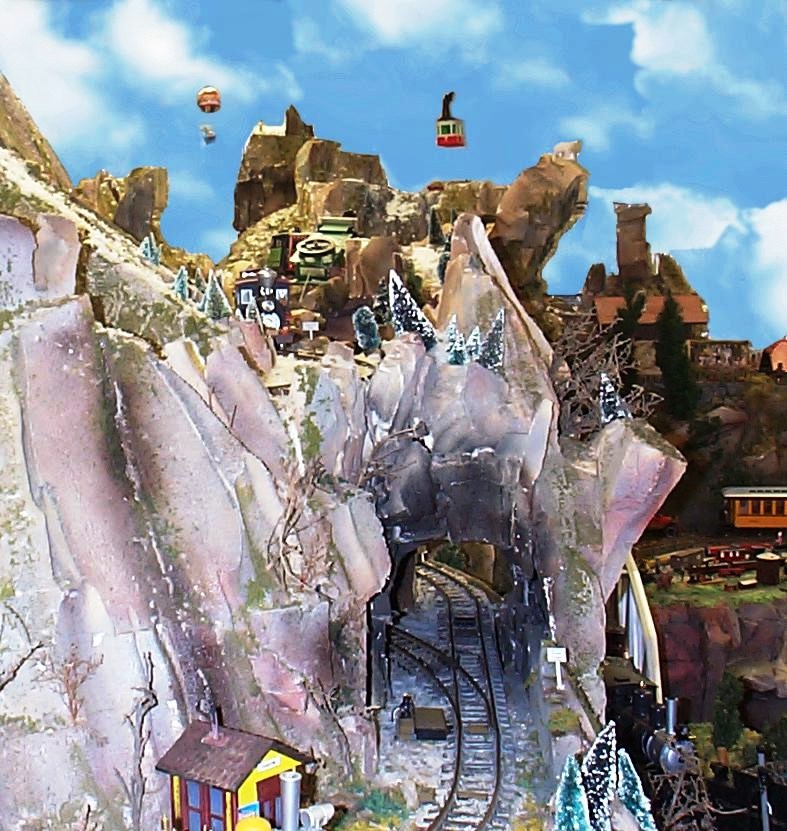
Hot
Air Balloon

Roundhouse and
Turntable -
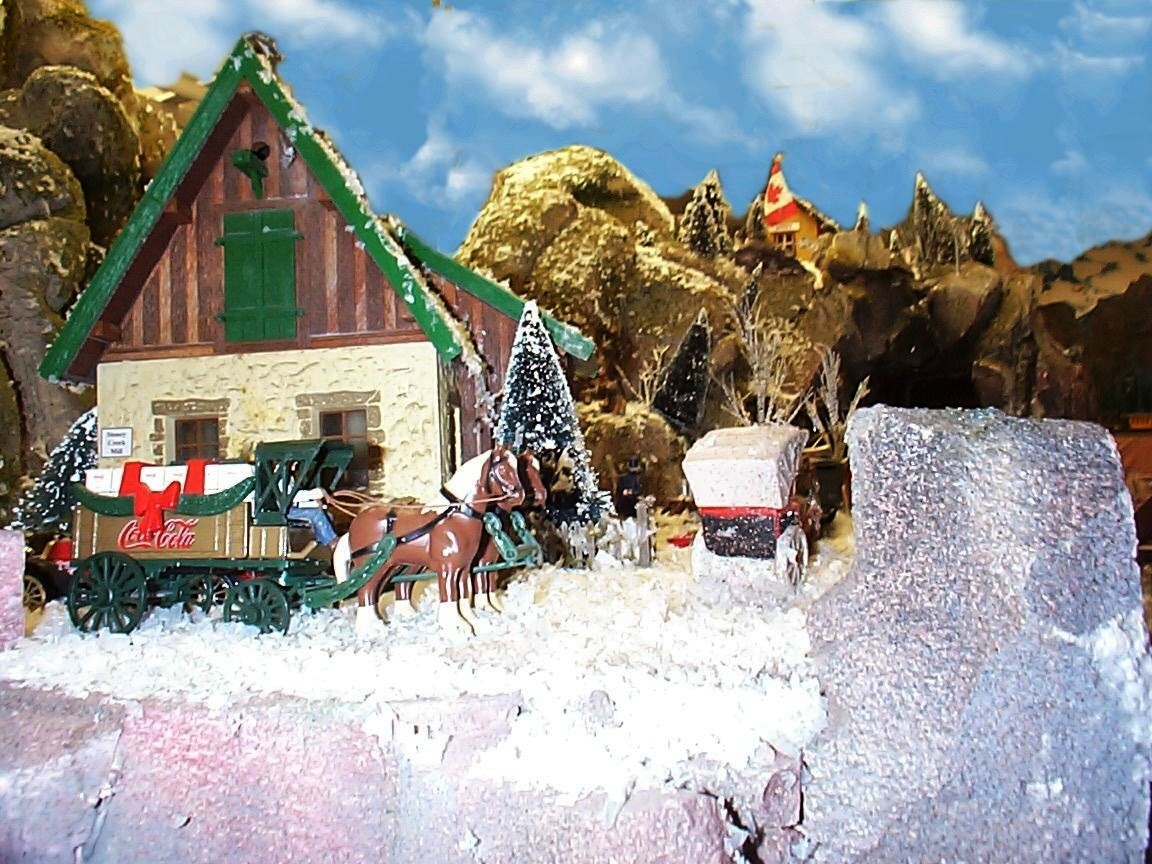
Snow
at Stoney Creek Mill -
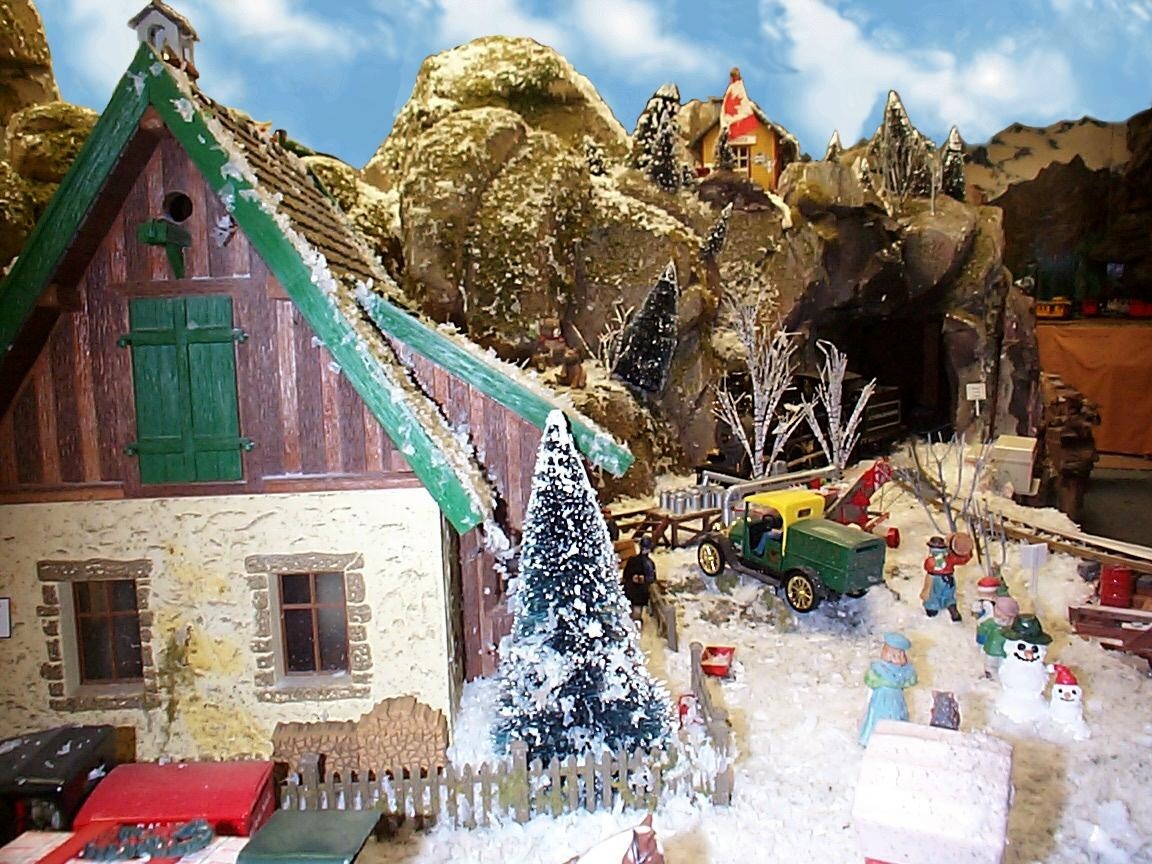
Snowmen

Banff Steel
Bridge -

Rail
Tie Car -
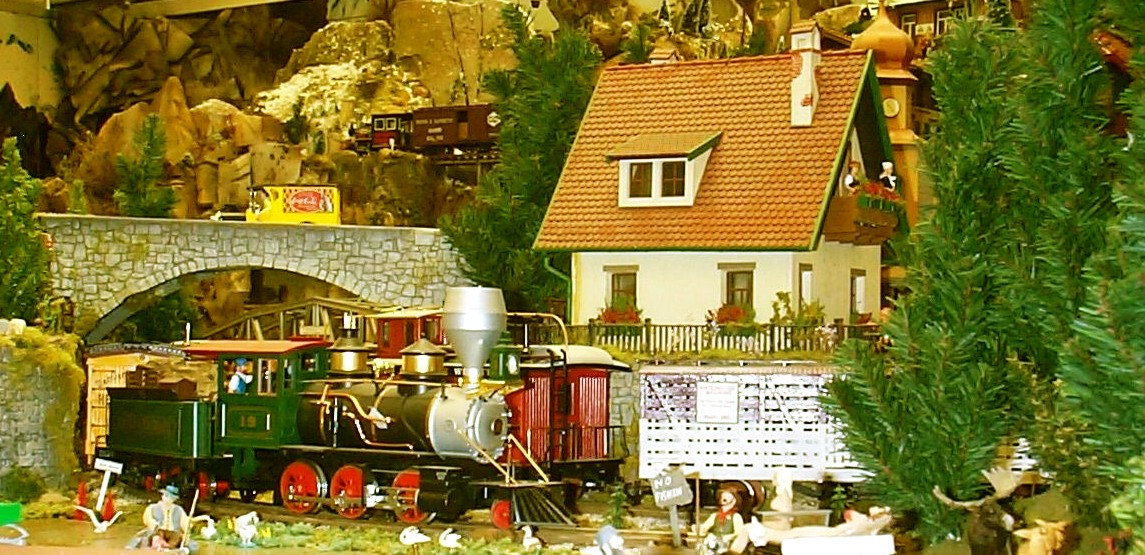
Banff
Stone Bridge
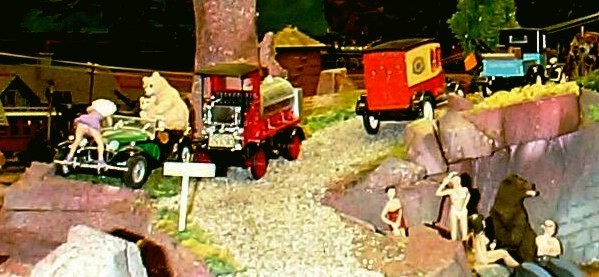
Bear Photographer
-

Wing Walker
-
 Photo
66:
Duck Pond Photo
66:
Duck Pond
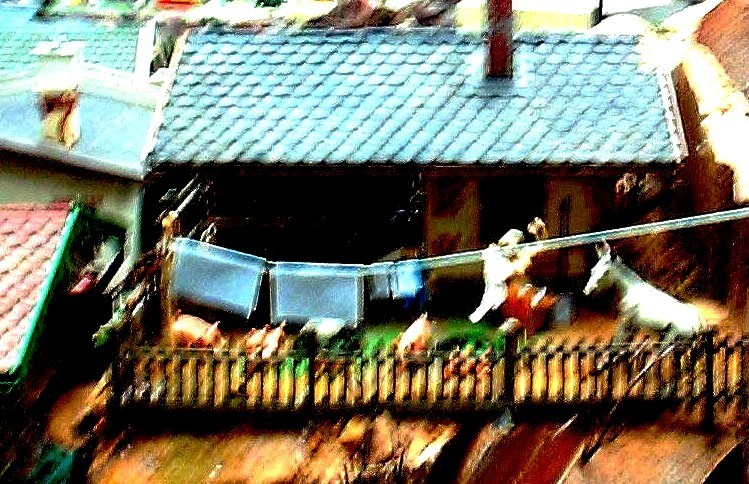
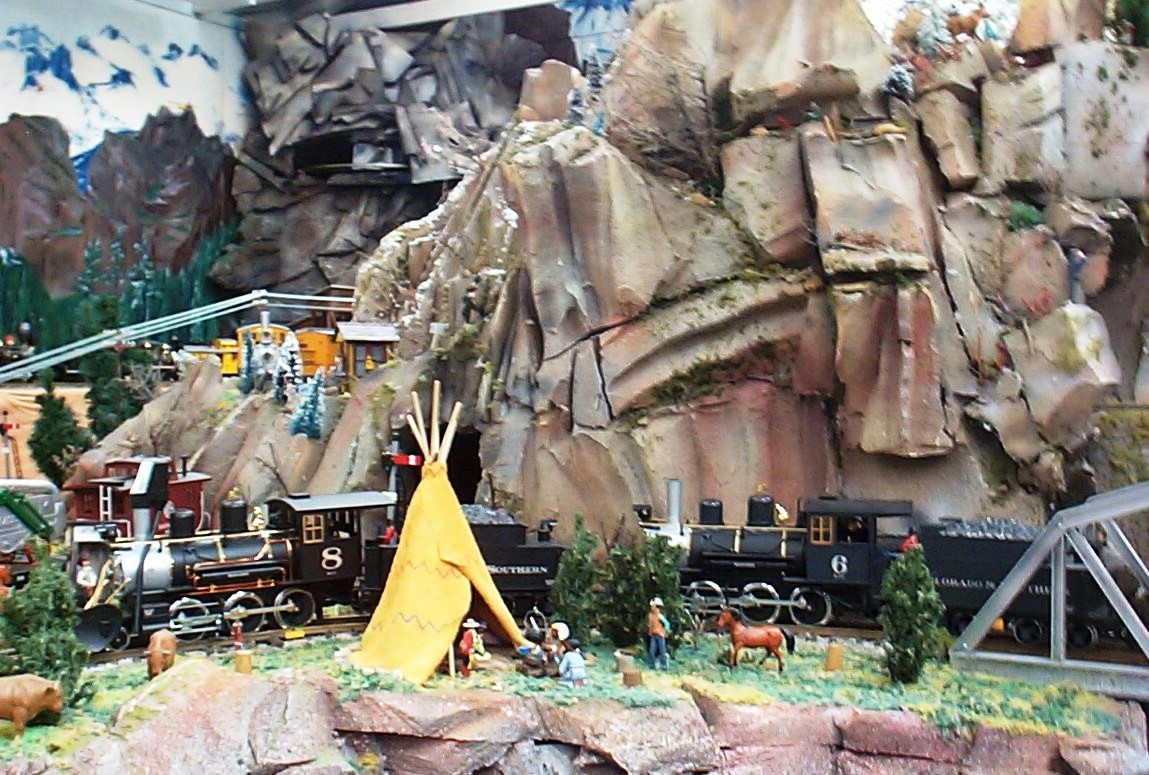
Hanging-Laundry
-

TeePee and
Train -
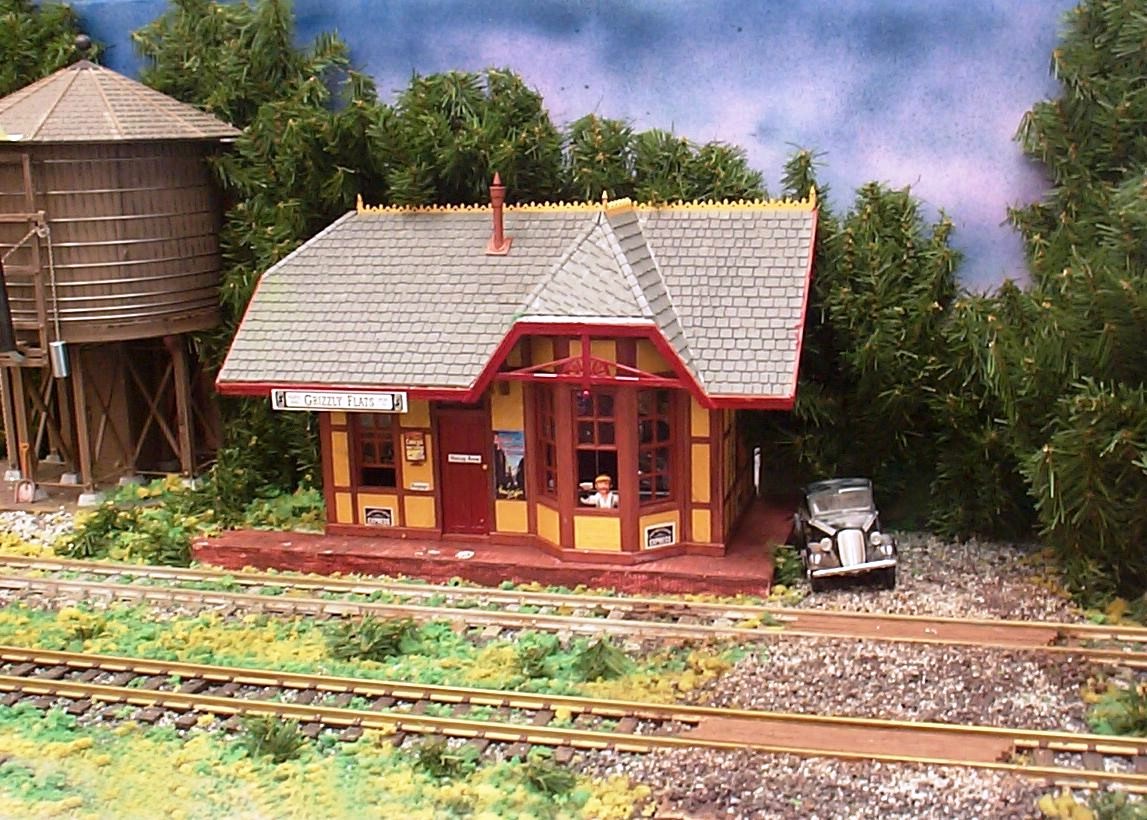
Grizzly
Flats Module
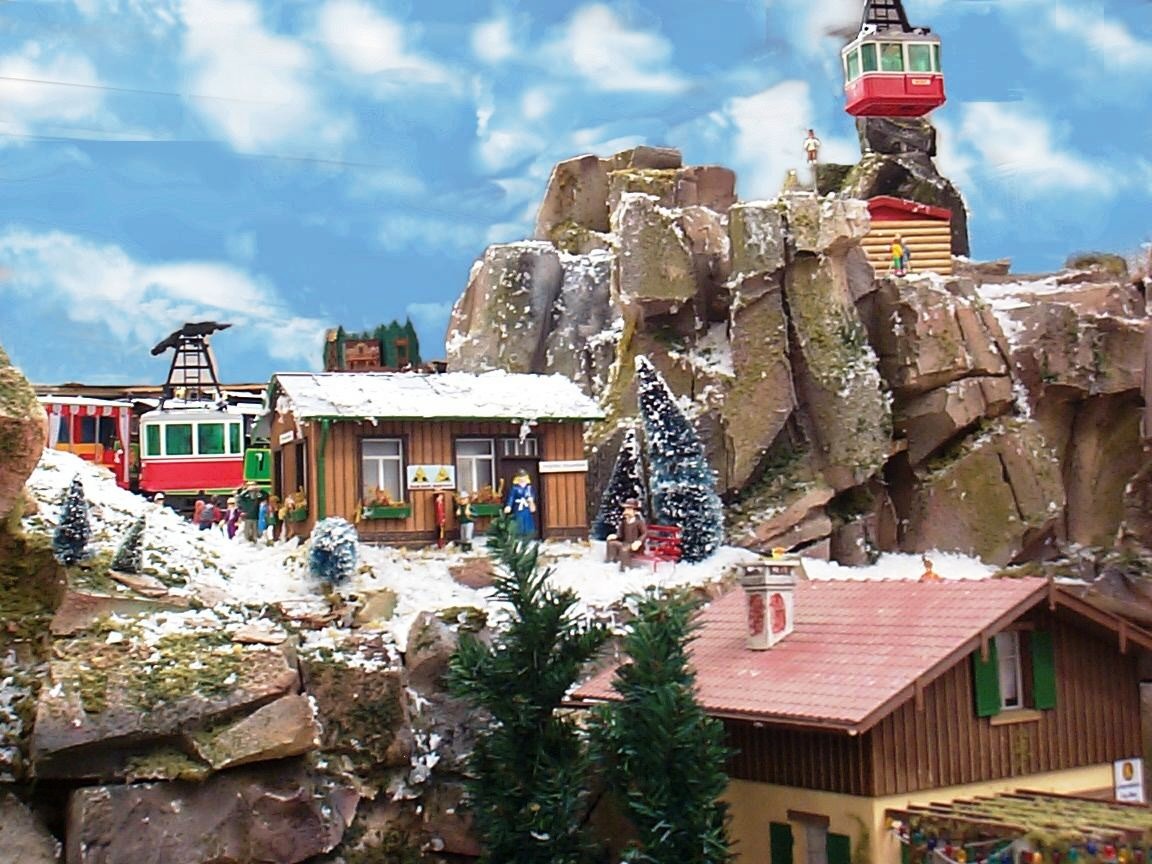
Sulphur
Mtn Station -
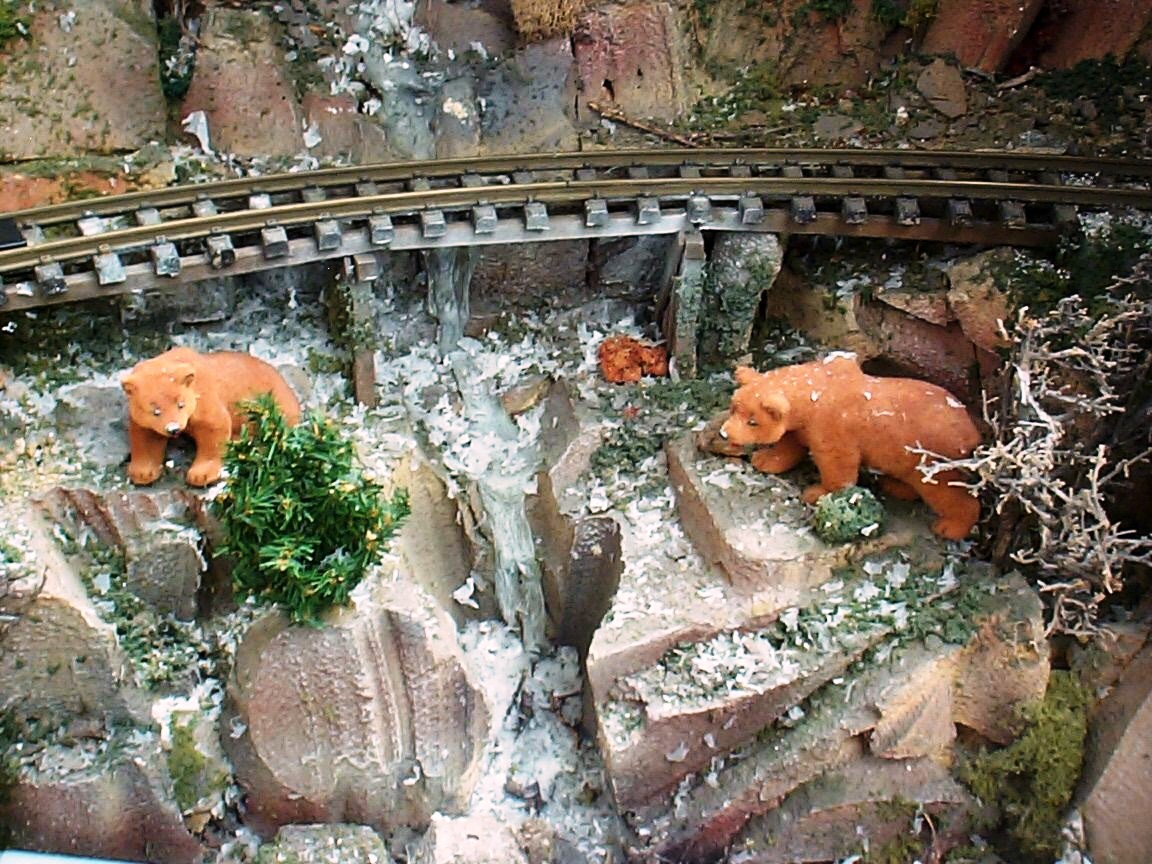
Bears
and Beavers at Devils Gulch -
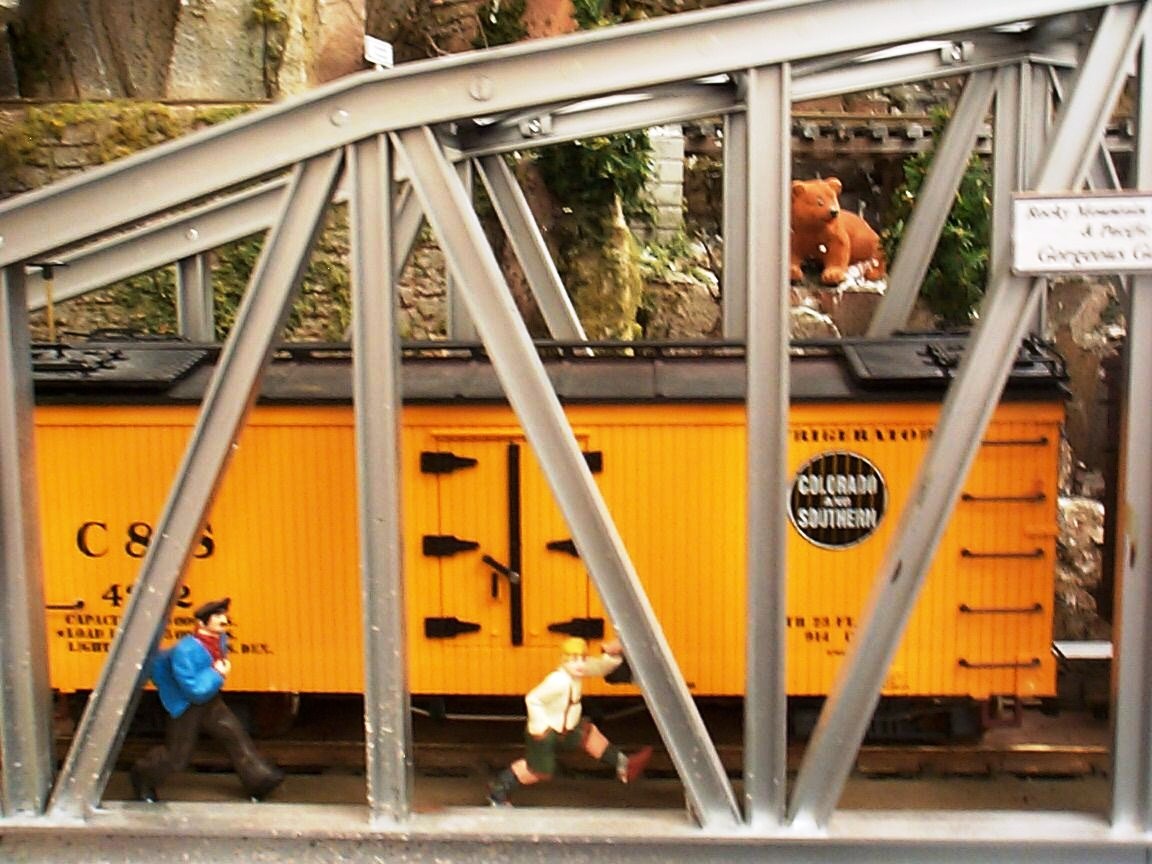
Catch
Me If You Can
|

 The Many Lives of Malcolm Furlow's "LGB
Empire"
The Many Lives of Malcolm Furlow's "LGB
Empire" The
railway started life as an LGB of America display at their
offices in San Diego in 1986. Designed and built by Malcolm
Furlow, a well-known artist and model railroader, it became
known as "Malcolm Furlow's LGB Empire". After two on display
at LGB, it was donated to the San Diego Model Railroad
Museum. In 1992 the LGB Empire was offered for sale in Model
Railroader magazine. With only a track plan and some
terrible Polaroid snapshots, a few dollars changed hands and
the eight 4x8 modules were headed north and a bit east to
central Alberta, about 2500 miles from San Diego.
The
railway started life as an LGB of America display at their
offices in San Diego in 1986. Designed and built by Malcolm
Furlow, a well-known artist and model railroader, it became
known as "Malcolm Furlow's LGB Empire". After two on display
at LGB, it was donated to the San Diego Model Railroad
Museum. In 1992 the LGB Empire was offered for sale in Model
Railroader magazine. With only a track plan and some
terrible Polaroid snapshots, a few dollars changed hands and
the eight 4x8 modules were headed north and a bit east to
central Alberta, about 2500 miles from San Diego. 



 This photo appeared in LGB
This photo appeared in LGB








































 Photo
66:
Photo
66:




